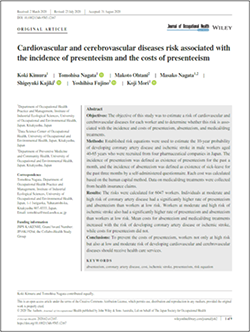#0087 Cardiovascular and cerebrovascular diseases risk associated with the incidence of presenteeism and the costs of presenteeism

Being Present While Away: The Hidden Burden of Employee Presenteeism
Employees’ health and well-being are closely related to productivity at the workplace. Along with the medical conditions of workers, two other factors that hamper workplace productivity of employees and create a financial burden on the employers are employee absenteeism and presenteeism. While absenteeism, or employees being absent from the workplace due to sickness, is one well-recognized concern of employers, in today’s world, the incidence of employee presenteeism is emerging as an even bigger burden in terms of productivity and financial health of the company. Presenteeism is the incidence of being physically present on the job but performing at a less than an optimal level or not being fully engaged in work because of illness, injury, or other causes. In countries with an aging and shrinking work population, such as Japan, where workers are prone to face stressful and long work hours, presenteeism accounts for a substantial drain in productivity.
Among Japanese workers, cardiovascular and cerebrovascular diseases are responsible for half of all incidences of death and one-quarter of work disability. With the rising cost of medical insurance and the pressing need for efficient productivity management, the Japanese government and companies are waking up to the necessity of looking deeper into the economic impact of employees’ health. Although the costs of medical treatments and absenteeism increase with disease-related risks, it has previously remained unclear whether the cost of presenteeism is also related to the risk of developing major diseases. To find the answer, we conducted a study involving 6047 male workers aged 40–65 years from four pharmaceutical companies in Japan. We calculated the cost related to self-reported incidents of absenteeism and presenteeism of these workers and collected data regarding their medical treatment-related costs from health insurance claims. We then assessed whether these costs were related to their risk of experiencing incidents of coronary artery disease and ischemic stroke within the next 10 years.
We found that workers at moderate and high risk of both the diseases showed a high rate of presenteeism and absenteeism. The study also revealed that, overall, the costs of presenteeism were much higher than those of absenteeism or medical treatments of the employee.
The results highlight the importance of preventing presenteeism to improve workplace productivity and developing effective strategies to promote health of employees.

Link to the original journal article:
https://onlinelibrary.wiley.com/doi/10.1002/1348-9585.12167
Title of the paper:
Cardiovascular and cerebrovascular diseases risk associated with the incidence of presenteeism and the costs of presenteeism
Authors:
Koki Kimura, Tomohisa Nagata, Makoto Ohtani, Masako Nagata, Shigeyuki Kajiki, Yoshihisa Fujino, Koji Mori




